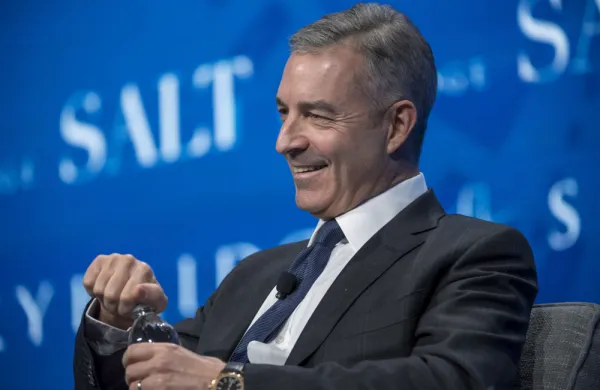I am late, very late, very late indeed. But I have an excuse: time zones. I’m in Los Angeles for the Milken Institute Global Conference, but my calendar is still on East Coast time. At least, I thought it was.
This particular meeting, with Cliff Robbins, founder and CEO of $3.4 billion hedge fund firm Blue Harbour Group, is set in my schedule for 10:30 a.m. I think that means the meeting is really at 1:30 p.m. EST. Thus, 10:30 a.m. EST finds me sitting in a breakout session of the conference, learning about climate change (it’s bad, getting worse.)
Except 10:30 really means 10:30. By the time I realize this, after some polite if urgent e-mailing from Robbins’s PR person, it’s closer to 11:30. There’s no quick way for me to leave the session. When I finally make it out and take the short elevator trip up to the fourth floor of the Beverly Hilton, where Robbins is holding court in a suite secured for the duration of the conference, the clock is inching closer to noon.
Robbins could be furious. This, after all, is Milken, a three-day marathon of networking and schmoozing, hosted by the think tank founded by legendary trader Michael Milken. Every half hour block is precious, and Robbins is an activist investor, part of a group of fund managers hardly known for their lack of ego or warm and friendly ways. Yet when I finally tumble through the door of his suite, Robbins is all smiles.
For those who know Robbins, this wouldn’t come as a surprise. The American investor is constitutionally and philosophically at odds with the image of the alpha-male, my-way-or-the-highway, flame-throwing activist hedge fund manager that has come to dominate both the popular imagination of activist hedge funds and, to a certain extent, the actual practice of hedge fund activism. Throughout his hedge fund career, Robbins has styled himself as a “friendly” activist. He likes to work with management to change a company and improve its performance. “My approach all along has been just be honest and direct with people,” he says. “We are respectful.”
For a gentleman activist, Robbins has a curious history, including a role in one of the most notorious hostile takeovers of all time. A graduate of Harvard University and the Stanford Graduate School of Business, Robbins — who grew up in Short Hills, New Jersey — joined private equity firm KKR & Co. in 1987 after working in the M&A department of Morgan Stanley. It was the height of the leveraged buyout boom, and KKR was embarking on its RJR Nabisco adventure. Robbins played an important role in the deal — he even features in the best-selling book on the buyout, Barbarians at the Gate — and served on RJR Nabisco’s board for many years. He strongly disagrees with the suggestion that KKR’s people were barbarians storming the walls of a storied company. Instead, he says, the firm worked well with management and taught him the value of doing so.
I know about Robbins’s KKR days, but I didn’t realize how well he had come to know Milken. “When I was at KKR, I did a lot of work with him,” says Robbins, referring to the man who almost single-handedly built the high-yield bond market.
Robbins’s second major touchpoint with Milken is far more personal. Milken survived prostate cancer and has made cancer one of the charitable causes with which he is most closely associated. After Robbins’s own father was diagnosed with cancer in the 1990s, Robbins reached out to Milken. Not only was Milken extremely knowledgeable and helpful, he was a huge source of support, even calling on weekends to see how Robbins and his family were coping. (Robbins’s father recovered.) Robbins was at the first Milken Institute conference, held in 1997 with about 80 people in attendance, and has been coming back ever since.
The now-59-year-old Robbins left KKR in 1999 to join tech investor General Atlantic, where he had worked as a summer associate more than a decade earlier. He returned in the heady days of the internet, and he saw a new synergy between venture capital and private equity, with larger companies looking to VC firms to structure carve-outs for them to access the growing tech sector. After the 2001 dot-com crash and a series of corporate scandals, Robbins identified a new opportunity. As a result of the scandals and ensuing reforms, he says, “boards began listening to their large shareholders more than they ever had before, and that kind of opened the door for our strategy.”
Launched in 2004 with $450 million in assets, Blue Harbour would be a different type of activist investor. Instead of crafting poison-pen letters, it would work with company management to improve profitability. It helps that Blue Harbour’s targets are mostly middle-market companies.
“Companies in the $2 billion to $10 billion market cap segment are fertile for our collaborative strategy because we’re welcomed as a resource,” says Robbins. Businesses of that size “tend not to be well covered by investment banks and sell-side research, and they often have more limited internal resources for analyzing new strategies, so we usually find that they have not previously considered the value-unlocking ideas we bring to the table.” Blue Harbour takes only a minority interest in companies and typically has about 15 stocks in its portfolio at any one time, ten of which are core investments.
According to investors, Blue Harbour’s long-only strategy has an annualized return of 10 percent since the firm’s founding. The strategy has been a performer at a time when hedge funds in general — including some high-profile activists — have been in a slump. Last year was particularly strong for Blue Harbour, which returned 15.5 percent, compared with 5.44 percent for the HFRI Fund Weighted Composite Index.
Institutional investors, some of which will not invest in more-hostile activist firms for fear of the consequences of challenging publicly traded companies, like Robbins’s approach. One prominent LP, the California State Teachers’ Retirement System, sees investing in Blue Harbour and a small handful of other activist managers as a way of improving corporate governance — part of CalSTRS’ overall sustainable investment approach, which includes the consideration of ESG (environmental, social and corporate governance) factors in relation to its overall investment portfolio.
When Robbins and I met a few years ago, he spoke with great enthusiasm about CalSTRS’ governance program. In a March letter to investors, Robbins announced that Blue Harbour was embracing a firmwide ESG strategy. Sitting in his LA hotel suite, he wonders, “What took me so long?” Since the firm’s inception, Robbins says, its leaders have thought of themselves as responsible investors. But “it’s an evolving space,” he notes. “There is a lot of interest and pressure building.” Appropriately, his panel session at Milken is on the topic of ESG.
Speaking of Milken, it’s time to get going. My half hour window has flown by. Robbins’s suite looks down on the hotel patio; in the sun’s glare the conference is in full swing. There are meetings to get to, sessions to attend, and networking to be done. On schedule, if possible.






